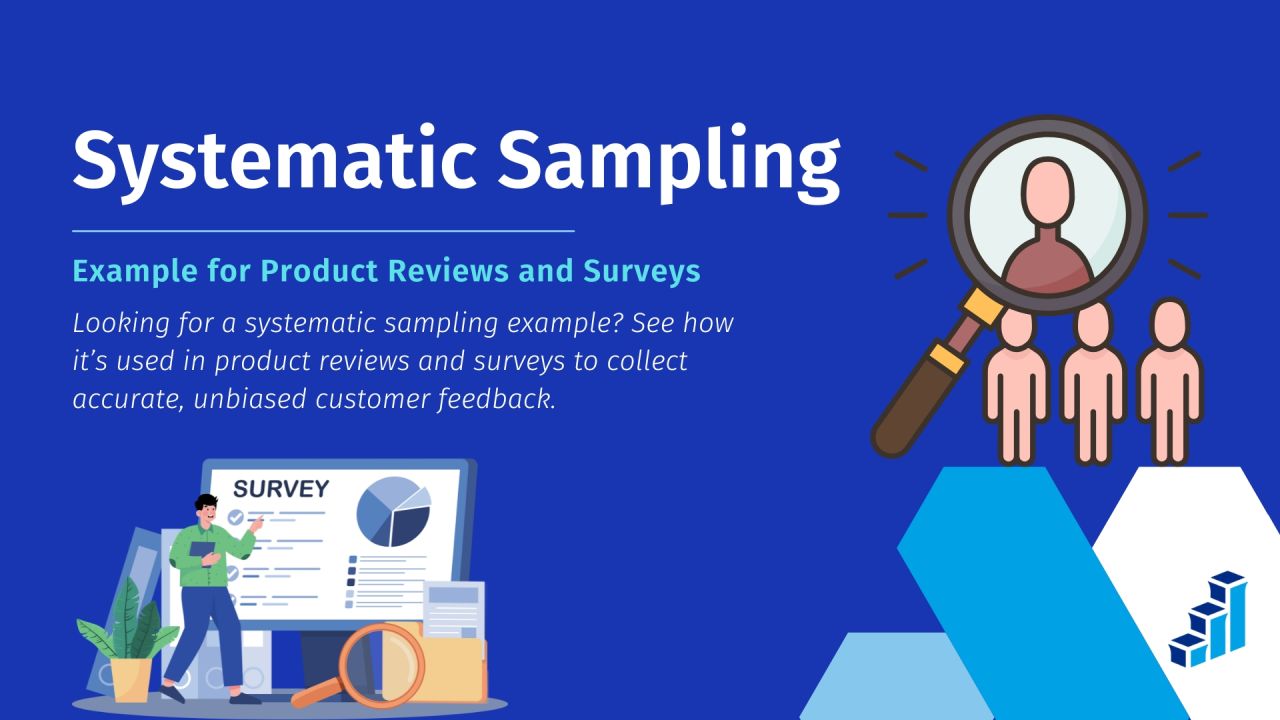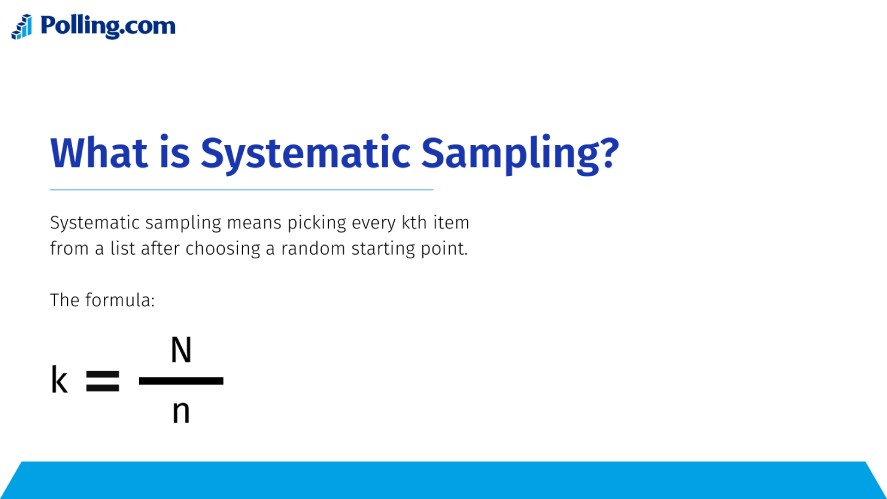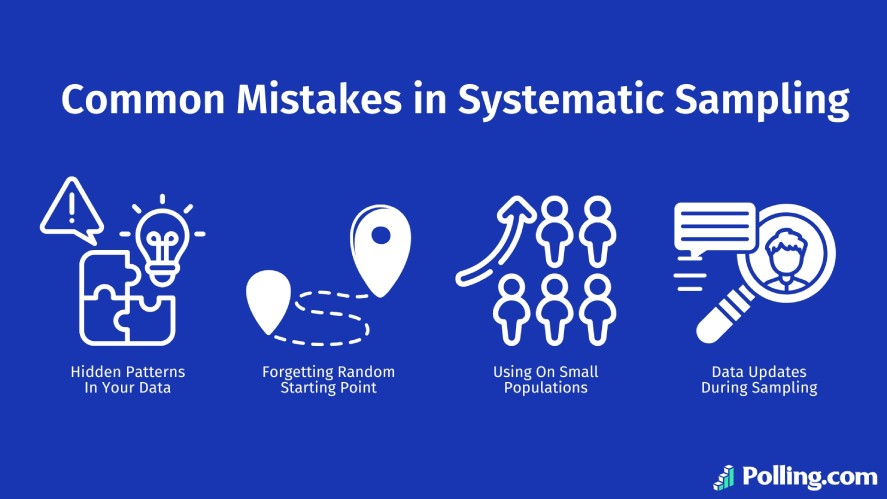
Systematic Sampling Example for Product Reviews and Surveys
Systematic sampling is a simple yet powerful method used to select data points or participants from a larger population at regular intervals.
Instead of picking items completely at random, this approach chooses every kth item after a random starting point, creating a structured and evenly spaced sample.
This method is widely used in research, marketing, and data analysis because it saves time while still providing a reliable representation of the whole dataset.
For example, marketers often use systematic sampling to analyze customer reviews, researchers apply it in surveys, and manufacturers use it in quality control to check every nth product off the line.
It’s efficient, unbiased (when applied correctly), and easy to automate with modern tools.
Let’s explore some real-world systematic sampling examples to understand how it works and why it’s one of the most practical sampling types and techniques today.
What is Systematic Sampling?
In simple terms, systematic sampling means picking every kth item from a list after choosing a random starting point.
Here’s the basic formula: k = N / n
Where:
- N = total population size
- n = desired sample size
- k = sampling interval (the gap between selected items)

For example, imagine you have a list of 1,000 customers and you want a sample of 100. Using the formula, k = 1000 / 100 = 10.
That means you’ll select every 10th customer after a random starting point between 1 and 10.
A real-world analogy: picture yourself standing outside a store and asking every 10th person who walks in to answer a quick survey.
You’re not picking at random, but your sample still represents the crowd fairly well, especially if the population has no hidden patterns.
This mix of structure and randomness is what makes systematic sampling both efficient and dependable for researchers and analysts.
Systematic Sampling Example #1: Survey Responses
Scenario: You’ve just finished an NPS (Net Promoter Score) survey with 5,000 total responses, but you only need a representative sample of 500 to analyze in detail.
Step-by-step:
- Calculate the sampling interval: k = N / n = 5000 / 500 = 10
- Choose a random starting number between 1 and 10 (for example, 7)
- Select responses 7, 17, 27, 37, 47… and continue until you’ve collected 500 responses
Outcome: This approach gives you a balanced, evenly distributed systematic sampling sample from your survey data, ensuring that every segment of your audience has a fair chance to be represented without needing to review all 5,000 responses.
Systematic Sampling Example #2: Product Reviews
Scenario: A company has 12,000 online reviews for its best-selling product and wants to manually analyze 600 of them for customer insights.
Steps:
- Calculate the interval: k = N / n = 12000 / 600 = 20
- Pick a random starting point, such as 14
- Select reviews #14, 34, 54, 74, 94… and continue until 600 reviews are chosen
Why it Works: This ensures the sample is spread evenly across the entire review timeline, avoiding bias toward any particular time period.
Practical Systematic Sampling Cases: Perfect for sentiment analysis, identifying recurring issues, or spotting product improvement opportunities based on real customer feedback.
Systematic Sampling Example #3: Stratified + Systematic Sampling
Scenario: You want to analyze product reviews by star rating while keeping the sample balanced across different satisfaction levels.
Grouping the reviews:
- 5-star reviews: 6,000
- 4-star reviews: 3,000
- 3-star and below: 3,000
Now, you’ll take 100 reviews from each group using systematic sampling.
Step-by-step:
- For 5-star reviews: k = N / n = 6000 / 100 = 60
- For 4-star reviews: k = N / n = 3000 / 100 = 30
- For 3-star and below: k = N / n = 3000 / 100 = 30
This approach ensures each rating category is fairly represented. It allows you to compare satisfaction levels, identify common complaints, and spot trends by star rating without oversampling any one group.
Common Mistakes in Systematic Sampling
Systematic sampling is one of the simplest and most efficient sampling methods, but it can easily lead to biased results if not used carefully.

One common mistake is applying it to data that follows a hidden pattern.
For example, if reviews or survey responses are sorted by time, rating, or region, selecting every kth entry could unintentionally favor certain types of results.
To prevent this, it’s best to shuffle or randomize your data before applying the method.
Another frequent issue is skipping the random starting point.
The whole idea of systematic random sampling relies on probability, and without a random start, your systematic random sample becomes predictable and less representative.
So, always pick a random number within your interval range before beginning your selection.
Systematic sampling also loses its effectiveness with small datasets. When the total number of entries is low, simple random sampling usually gives more accurate representation
Finally, make sure your dataset is stable while you’re sampling.
If data is being updated, such as new reviews or survey responses coming in, the intervals can shift, leading to uneven or duplicated selections.
To avoid this, always freeze or export your dataset before you begin the sampling process.
Tools You Can Use for Systematic Sampling
You don’t need advanced coding skills to perform systematic sampling. There are plenty of tools that make it simple and efficient.
If you’re working with surveys or product feedback, Polling.com offers built-in options for sampling, review analysis, and feedback segmentation.
For spreadsheet users, Excel is a great starting point. Functions like =OFFSET() and =INDEX() let you pick every kth item automatically once you’ve calculated your interval.
Similarly, Google Sheets is a lightweight option that works well for small to mid-sized datasets.
If you prefer automation, Python’s pandas library is one of the most powerful tools available.
With just a few lines of code, you can easily create systematic samples, repeat them for testing, and even integrate them into larger data workflows.
When to Use Systematic Sampling — and When Not To
Systematic sampling can be a time-saving and reliable method, but it’s not always the best fit for every dataset.
Here’s a quick comparison to help you decide when to use it, and when to look for other sampling and techniques instead.
| When to Use Systematic Sampling | When Not to Use Systematic Sampling |
|---|---|
| You’re working with a large dataset that needs broad coverage. | Your dataset is small or has too few entries for intervals to matter. |
| You want a simple, evenly spaced sample without manual effort. | The data is highly clustered or sorted in a biased way (e.g., grouped by date or region). |
| You need a representative overview of responses or reviews. | You require detailed subgroup analysis, such as by age, region, or rating. |
| Your data is time-ordered (e.g., sales logs, surveys, feedback timelines). | The data has recurring patterns that may align with your interval (k). |
| You value speed and scalability over complex segmentation. | You’re studying rare events or niche categories where randomness matters more. |
Conclusion: Systematic Sampling is Simple, Powerful, and Scalable
Systematic sampling is one of the most practical methods for handling large amounts of data efficiently. When applied correctly, it saves time while maintaining a high level of accuracy.
From customer surveys to product reviews, it helps researchers and businesses draw meaningful conclusions without analyzing every single record.
If you’re looking for ways to streamline your sampling process, tools like Polling.com can help you automate the work and focus on insights rather than manual selection.
Try incorporating systematic sampling into your next research or feedback project; it’s a small step that can lead to big improvements in data quality and decision-making.
